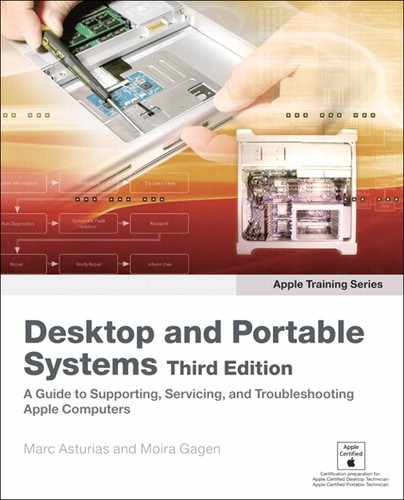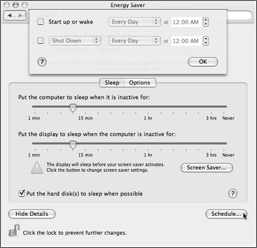Lesson 6. Power Management
Time
This lesson takes approximately 1 hour to complete.
Goals
Explain the different power and operating modes in Apple systems
Describe power-saving techniques for Apple systems
Describe how to calibrate a portable system’s main battery to ensure optimal battery performance
Apple reduces a product’s energy consumption in two ways: by using hardware components that require less power, and by using power management software to modulate the energy consumption of these components. The combination of hardware and software that control power supplied to the computer is referred to as “power management.”
Power management in Apple computer products includes the PMU, the SMU or SMC, the battery, and the Energy Saver pane in System Preferences. The PMU, SMU, and SMC were covered in Lesson 5b, “Underlying Technologies” (which can be found on this book’s companion website, www.peachpit.com/ats.deskport3), therefore this lesson focuses on other elements.
Although power management is present in both desktop and portable computers, energy consumption is most critical in the portable products because they can be run solely on batteries. Desktop computers also include power management preferences to comply with energy-saving regulatory rules.
This lesson focuses on power management issues that specifically pertain to portable computers, although most information applies to desktop models as well.
Power Management Components
All Apple portable computers (PowerBook, iBook, MacBook, and MacBook Pro models) may be powered either by a rechargeable lithium-ion battery or by an AC power adapter.
A variety of features programmed into the operating system enable the user to monitor the charge level of the battery and to control the computer’s power usage. How the user configures these power management features and operates the computer while under battery power determines how long he or she can use the computer before recharging it. These same factors can also affect the battery’s longevity—how long the battery lasts before it needs to be replaced.
Portable computers require a more complex power management software and hardware than desktop computers because they can be run off a battery. Portable power management must be able to activate and deactivate different components to save power, including the following:
• Display backlight
• Any installed PC Card
• Chipsets not being used, such as sound circuitry
• Processor speed reduction
Power Modes
All computers have four power modes:

Of these four power modes, sleep and Safe Sleep modes require additional explanation.
There are several ways to put a portable computer into sleep mode:
• Choose Sleep from the Apple menu (Mac OS X).
• Press the power key for two seconds, and click Sleep in the dialog that appears (available on models with a power key).
• Close the portable case.
System software can attempt to place the computer into sleep mode automatically after a certain period of inactivity. You can specify this period of time in Energy Saver preferences (described later in this lesson). However, the computer will not go into sleep mode automatically if any of the following conditions are true:
• The computer is connected to a shared disk on the network.
• The computer’s printer or modem port is in use.
• Sleep is set to Never in the Energy Saver preferences.
• DVD Player is the active application.
To wake a sleeping Mac, press any key except Caps Lock.
Safe Sleep mode is a new feature introduced with the PowerBook G4 (Double-Layer SD) and continuing through MacBook Pro. Prior to the system entering sleep, the current state of the computer is saved to the startup volume, including items such as desktop settings, open applications, and any work in progress. Safe Sleep also ensures that data stored in main memory will not be lost should the system shut down due to a loss of power or if the battery runs down during sleep mode. When a power adapter is connected or a freshly charged battery is installed, the computer can be restarted and it will automatically return to the desktop state that existed prior to entering sleep.
When the system is in Safe Sleep, the computer is completely powered off. You cannot wake a portable that is in Safe Sleep by simply pressing any key the way you would if in sleep mode only, because the keyboard is not monitored by the system when it’s powered off. The only way to awaken a system in Safe Sleep is to press the power button, as this button alone is directly connected to the power management chip.
Upon restart, a progress bar indicates that the original state of the system is being restored.
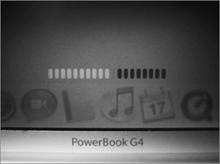
Applications and files will remain exactly as they were prior to the system being put into Safe Sleep mode.
Note
Before proceeding further in this lesson, fully review the following Knowledge Base documents: 25801, “Energy Saver: About sleep and idle modes in Mac OS X”; 302477, “Progress bar appears after waking from sleep”; and 303329, “How to swap the MacBook Pro battery.”
Power Adapters
Each Apple portable model ships with a power adapter, which is used to power the computer and recharge its main battery.
Some power adapters may look identical, even down to their connectors, but they may have different wattage ratings. There are four types of white power adapters for Apple’s current PowerBook G4, MacBook Pro, iBook G4, and MacBook models. Each has a different power rating: 45 watts (iBooks and some PowerBooks), 60 watts (MacBooks), 65 watts (some PowerBooks), and 85 watts (MacBook Pros). All current white square power adapters are clearly marked with their wattage. Older unlabeled white square power adapters are all 45-watt models.
45-watt adapters should not be used with computers that require 65-watt adapters, because doing so may affect the computer and its ability to charge the main battery. However, 65-watt adapters can be used with any of the computers that shipped with 45-watt adapters, because using the higher-wattage adapter will not affect the computer or battery performance. The 45-watt and 65-watt power adapters use the same type of connector, so make sure you read the wattage marking.
In addition, the 60-watt and 85-watt power adapters both use a MagSafe connector that is not compatible with the other two models. The same rule applies in that you may use an 85-watt adapter with a computer that requires a 60-watt adapter, but not vice-versa.
For best results, always use the power adapter that came with the computer.
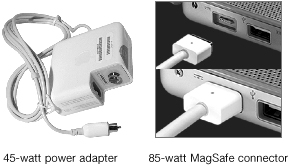
More Info
Refer to Knowledge Base documents 75448, “Apple Portables: Identifying the right power adapter and power cord,” and 302461, “Troubleshooting iBook, PowerBook G4, and MacBook Pro power adapters” for more information on power adapters.
Batteries
All portable models ship with a main battery. Some models also have a backup battery. Apple maintains an informative website specifically for battery information: www.apple.com/batteries. This website contains useful information about the care and handling of Apple batteries and battery-operated products, such as PowerBooks, iBooks, and iPods.
Refer to the following Knowledge Base documents for information about specific battery-related issues:
• 86797, “PowerBook and iBook: Identifying the right battery”
• 10571, “About PowerBook and iBook Battery Storage Life”
• 86181, “Macintosh Family: Batteries and Part Numbers, Part 2”
• 106216, “Mac OS X, Portables: Batteries shouldn’t be changed when computer is sleeping”
• 303785, “Intel-based Apple Notebooks: About the battery”
• 86284, “Calibrating your computer’s battery for best performance”
• 30017, “PowerBook: Testing Backup Battery”
• 86440, “PowerBook, iBook: Battery Life”
• Apple battery website - www.apple.com/batteries
Lithium-Ion Batteries
Apple uses rechargeable lithium-ion (Li+ or Li-Ion) batteries in many of its recent portable computers. A lithium-ion battery should retain a minimal charge needed to operate a portable computer for one to two months. Lithium-ion (Li-Ion, or Li+) batteries are not subject to the memory effect and, therefore, have no need for periodic reconditioning. However, if the battery is not used for two to three months, you should recharge the battery. A lithium-ion battery stored for up to 12 months should still be able to accept a charge. Lithium-ion batteries are sensitive to heat and cold and may be permanently damaged by exposure to temperature extremes, so use and store these batteries only in reasonably temperate environments. Think about it this way: If the temperature feels uncomfortable to you, it’s probably too hot or cold for your lithium-ion battery as well.
Lithium-ion batteries have battery level indicator lights that tell whether the battery is fully charged, three-fourths charged, one-half charged, one-fourth charged, or depleted. A blinking battery light indicates a problem with the battery. To check the battery status, press and hold the battery button until the indicator lights are on, to check the charge status of the battery.
With the introduction of the Intel-based MacBook and MacBook Pro, Apple included a new type of battery, the lithium polymer battery. Although the underside of the battery may state that it is “Li-Ion,” it is using the lithium polymer implementation of this technology.
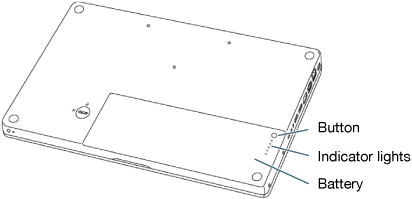
More Info
The memory effect, or lazy battery effect, was prevalent in older battery technologies, including nickel-cadmium rechargeable batteries. For additional information, visit www.answers.com/topic/memory-effect.
Battery Calibration
You can calibrate your iBook, PowerBook, MacBook, or MacBook Pro computer’s lithium-ion battery for best performance.
The battery has an internal microprocessor that provides an estimate of the amount of energy in the battery as it charges and discharges. The PMU, SMU, or SMC in the computer reads this information from the battery and passes it along to Mac OS X for display to the user as either a time-based readout (such as 2:15 remaining) or percentage-based readout (such as 72%). Over time, after numerous repeated charge/discharge cycles, partial charge cycles, sleep/wake cycles, possible battery swaps, and other various interruptions, the battery microprocessor may no longer have an accurate estimate of the battery’s energy range, which could result in an erroneous onscreen battery display. The battery needs to be recalibrated from time to time to ensure that the onscreen battery time and percent display remain accurate. With all iBooks and PowerBook G4 computers, except the aluminum PowerBook G4 (15-inch Double-Layer SD), you should perform this procedure when you first use your computer and then every few months thereafter. This calibration is also recommended in the newer Intel-based MacBook and MacBook Pro computers as well.
More Info
To review battery calibration procedures, consult Knowledge Base document 86284: “Calibrating your computer’s battery for best performance;” for Intel-based portables, visit http://docs.info.apple.com/article.html?path=Mac/10.4/en/mh2339.html.
Battery Storage
When storing batteries for a long period of time (for example, over the summer school break), a user should fully charge the battery and then use the computer until the battery has depleted 50 percent. The user may then shut down the computer, remove the battery, and store it in a cool, dry place.
Note
When the battery is inserted in the computer, it creates a closed circuit. So, even if the computer is shut down, the battery will eventually drain.
Low-Power Messages
When the battery charge drops to about 1 percent, the computer displays a low-power message. If you continue working until the computer goes to sleep automatically, you may not be able to wake it again until you plug the computer into AC power. If you are unable to plug in the AC power adapter immediately, the contents of RAM are preserved in sleep mode for at least two days. During this time, you should be able to wake the computer and resume work where you left off after it has been plugged in to the AC power adapter, provided the battery has not been removed in the interim.
Tip
Recharge a depleted battery as soon as possible. Leaving a depleted battery in the computer for longer than two weeks (especially in a hot location, such as the trunk of a car) may damage the battery so that it can’t be recharged. If your battery falls into a deep-discharge state, you must replace the battery.
Battery Recharge
To recharge a battery, simply plug in the AC power adapter. You do not need to shut down the computer before plugging in the adapter, but always connect the adapter to AC power before you attach the adapter to the computer.
Tip
If you connect the AC power adapter to the computer before you connect the adapter to an electrical outlet, you run the risk of making the Power Manager software unusable. Symptoms of issues with the Power Manager software include startup problems and the inability to shut down the computer (the computer restarts spontaneously after shutdown). To resolve this issue, you need to reset the PMU. Procedures for resetting the PMU differ depending on the model; you can find them in the appropriate service manual and in Knowledge Base document 14449, “Resetting PowerBook and iBook Power Management Unit (PMU).”
You can continue to use the computer while the battery is recharging, but the battery will take longer to recharge if you do. Battery recharging time while the computer is in use depends on how often you use the hard drive, how bright the screen is, whether you are using an external monitor, how completely the battery is depleted, and other factors.
If you are using several power-consuming features such as an external monitor or a program that requires frequent hard drive access, and you are not using the features designed to conserve power (such as reduced processor speed), the battery may not recharge until you put the computer to sleep or shut it down. Simply put, the more power you consume during computer use, the less power is available to recharge the battery.
While the computer is shut down and the AC power adapter is plugged in, you can remove a charged battery from the computer and replace it with another battery you want to charge. If you do this, remember to reconnect the AC power adapter to recharge it.
Power Conservation
Two portable computer operations drain the battery the most—using the backlight on the screen and using the hard drive. To increase battery life, reduce the use of these components. Set the hard drive to spin down quickly and turn off or lower the brightness of the backlight. Using the slower processor speed also increases battery life. When not in use, put the computer to sleep.
To get the maximum amount of power duration from your portable’s battery, you need to set the Energy Saver preferences properly and adhere to the following usage tips.
Energy Saver Preferences
The most important tools for managing power consumption on a portable are found in Energy Saver preferences. Choose System Preferences from the Apple menu, and then click Energy Saver.

The Energy Saver preferences are used to specify when the screen dims and when the hard drive spins down. You can use the provided presets or customize preferences for battery use and power adapter use.
In the Sleep tab, you can specify a global setting (put system to sleep) or specify separate settings for the display and the hard drive. To save power, you can simply set the entire computer to go to sleep after a particular period of inactivity. You should get into the habit of putting the computer to sleep when not in use, because this conserves the most power, short of shutting the system down. Waking a computer from sleep takes only a few seconds, but if you find this delay unacceptable, consider at least turning off the display separately and putting the hard disk to sleep when possible. Note that Energy Saver preferences apply to all users of the computer, not just the user that is currently logged in. You must have administrator-level access to the computer to change Energy Saver preferences, which is why you see a lock icon in the lower-left corner of this system preference. A few other system preferences, such as Networking, also behave this way.
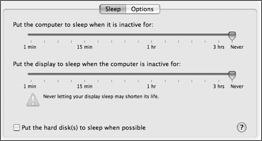
Note the warning when the computer and display are set to never sleep.
Note
If you specify a separate sleep delay for the display, the Mac OS will automatically partially dim the backlighting at half that setting, and completely turn off backlighting when the full period of inactivity has elapsed.
The Schedule button enables you to set startup and shutdown times for your system.
On the Options tab, you can control the computer’s waking on modem or network activity, restarting automatically after a power failure, display brightness, and the battery status icon.
Keep a close eye on the battery level. Select the “Show battery status in the menu bar” checkbox to add a battery icon in the menu bar that displays either the time remaining or the percent of battery power remaining. Keep in mind that these estimates are based on the battery’s average consumption. If, for example, you begin using the optical drive to watch a DVD, you will notice the time remaining drop accordingly.
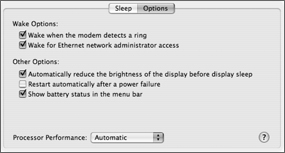
Deselect the “Wake when the modem detects a ring” checkbox unless you really use your computer’s modem to accept incoming calls for faxes or remote access connections. Constantly checking the modem for incoming calls requires power.
On many portable and desktop models introduced since May 2001, users can elect to reduce processor speed, if they are running Mac OS X 10.1.5 or later. Simply choose Reduced from the Processor Performance pop-up menu. You may notice a perceptible slowdown, but you’ll benefit from increased battery life. The slower the CPU runs, the less power it consumes, and the less heat the computer generates overall.
More Info
For additional information about Energy Saver options, refer to “Mac OS X 10.4 Help: Setting Energy Saver options for your computer” (http://docs.info.apple.com/article.html?path=Mac/10.4/en/mh1669.html).
Power-Saving Techniques
Knowing how to manage a portable computer’s energy is important. The number-one power-saving tip is to use the AC power adapter as often as possible. You can control many of the hidden areas of power consumption by following a few simple tips and techniques that can affect battery usage.
Settings and Controls
You can easily set the following operating-system settings to minimize power consumption:
• In Energy Saver preferences, select the option to put the display to sleep automatically.
• In Energy Saver preferences, select the option to put the hard disk to sleep automatically. (The default is on, so you will have to change it manually.)
• Turn off AirPort and Bluetooth when not in use.
• Watch your battery level carefully. Choose to show the battery in the menu bar, showing either time remaining or percent remaining. The displayed battery level is only an estimation based on the battery’s current average consumption. For example, the menu bar could display 2 hours of remaining power, but the battery might last only 1.5 hours after the hard drive or optical drive starts spinning. The estimated time remaining will rise again if the hard drive goes back to sleep.
• Reduce processor speed by choosing Reduced from the Processor Performance pop-up menu in Energy Saver preferences. This reduced setting slows down the computer a little, but the battery life is increased. (This setting is not available in all models.)
• Reduce screen brightness (backlight). Dim the screen to the lowest comfortable level to achieve maximum battery life, since the screen is one of the largest power consumers in a portable. You may be able to dim the screen brightness considerably and still be able to work without any problems.
Application Software
Here are several tips for conserving battery power while using different applications:
• Under battery power, don’t use applications or features (such as spell-checking or QuickTime) that require lots of hard drive access.
• Use applications suited to nomadic use. Don’t use resource-consuming applications if you do not require their features. Use a light word processing application such as AppleWorks or TextEdit rather than Microsoft Word, which is processor-intensive. Games and graphics applications such as Adobe Photoshop keep the hard disk actively spinning, which drains the battery more quickly.
• Set up locations files optimized for different environments. Suggest prioritizing different network interfaces for each place that the user uses his or her computer. The customer may, for example, prefer internal modem when at home but AirPort when at work or school.
• Simultaneously open the files you want to work on so the disk spins up a single time.
• You may elect to run frequently used programs off a RAM disk, especially if they are disk-intensive.
• When near an AC outlet and planning to use battery power later, launch the applications and open data files with AC power, then put the computer to sleep. Your work will be in RAM when the computer is awakened from sleep.
Peripherals
Use the following tips to conserve battery power when using peripheral devices:
• As soon as the user is finished with the modem, quit any program that uses it.
• Turn off the “wake on ring” and “fax receive” options for modems.
• Disconnect the modem cable—a connected modem, even when not in use, drains power (remove the modem cable from the computer, but it may remain in the wall phone jack).
• Disconnect peripherals because some peripherals are not self-powered (USB mouse, or even a FireWire hard disk even removed from the desktop). Peripherals may draw power from the portable computer, even if they’re not actively in use.
• Deactivate and remove any cables from unused ports, even if not in use.
• Use the disk drive as little as possible and eject any optical discs not in use.
• Use only low-power USB devices that are designed for portable computers.
• Remove any PC Cards from the PC Card expansion slot. Some cards draw power even when they are not in use.
Energy-Saving Standards
In addition to allowing users to work as long as possible unrestrained by cables, the power management system meets the following energy-saving standards:
• Energy Saver
• The U.S. Environmental Protection Agency (EPA) ENERGY STAR program, of which Apple was a founding member
• The California Energy Commission appliance efficiency regulations
• The U.S. Federal Energy Management Program (FEMP)
• The European Union Code of Conduct on Efficiency for External Power Supplies
• Blue Angel (Germany)
To meet these standards, the default configuration of the computer must draw less than 7 watts in sleep mode and less than 5 watts in off mode while plugged into the AC adapter and with the battery removed.
More Info
For further information regarding these standards, consult www.apple.com/environment/energyefficiency.
Troubleshooting
Troubleshooting the power system can be difficult. Power is potentially distributed over several boards and connectors. In addition, a number of settings and use patterns could contribute to the symptom. In portable computers, a main battery is added to this list of variables. Many interconnected points could individually or in some grouping cause the symptom you’re trying to resolve.
If portable users complain that they do not seem to be getting the battery life they once did, check that proper power conservation settings have been set in Energy Saver preferences and, if necessary, reset the Power Manager. Also, check whether the portable’s main battery has had an excessive number of charge cycles and is now depleted (worn out), requiring replacement. This is easily verified using System Profiler in Mac OS X v10.4 and later, and looking in the Power section under Cycle Count. Compare this to information in www.apple.com/batteries/notebooks.html to verify if the battery is depleted.
User Settings
After you verify the problem, you can start eliminating areas of potential causes, starting with user error or settings.
Start by considering the power-saving tips discussed in the previous section to see if you can return the computer to optimum performance. Ensure that no settings or running applications are preventing the portable from realizing energy savings.
Support Pages
The Apple Support site is another resource that can assist you in troubleshooting power management issues. The support pages for iBooks, MacBooks, PowerBooks, and MacBook Pros have detailed advice on how to conserve power and investigate power-related issues.
Power Management Resets
In Lesson 5b, you were introduced to the PMU, SMU, and SMC. These system elements are often reset as part of investigating power management issues. Before attempting a reset, make sure that you have located the correct reset procedures for the model under repair.
The computer’s power is managed by an integrated circuit (computer chip) located on the logic board. Depending on the model, it may be a PMU, SMU, or SMC. It is responsible for managing the computer’s power, including hard disk spin down, sleep and wake, some charging aspects, fans, and how any devices attached to the computer affect sleep.
If the settings of this power management chip become corrupted over time, you may notice abnormal conditions such as your computer not turning on, not displaying video, or not waking from sleep. These situations may require you to perform a reset, but don’t do so as a first resort.
Resetting the computer’s power management returns the computer hardware, including NVRAM, to default settings and forces the computer to shut down. Performing a reset will not resolve a computer being unresponsive or sluggish. Only perform a reset if your computer hardware is believe to have failed or in situations where the power management system is suspect.
Before performing a reset, try restarting the computer. If you cannot perform a normal restart, you may need to Force Quit (Option-Command-Escape) the application you are using and/or Force Shutdown (press the power button for 10 seconds). If restarting the computer doesn’t solve the problem, perform a reset. Again, reset procedures vary from system to system, so verify that you are using the correct procedure for your particular model.
Lesson Review
1. What power modes were discussed in this lesson?
a. Awake, sleep, energy saver, shut down
b. Awake, sleep, safe sleep, and shut down
c. Awake, sleep, and shut down
2. Which power mode uses the least power?
a. Sleep
b. Safe Sleep
c. Shut down
3. System software can attempt to place the computer into sleep mode, unless:
a. Sleep is set to 15 minutes in the Energy Saver pane.
b. The hard disk is sleeping.
c. DVD Player is the active application.
d. Battery status is set to display in the menu bar.
4. In which System Preferences pane do you set separate timing for display dimming?
a. Energy Saver
b. Displays
c. Desktop & Screen Saver
5. True or false: While it is sleeping, a portable normally shuts down when the display is opened.
6. True or false: The power management reset is the first option you should use when diagnosing or repairing a sleep issue.
7. Which AC power adapters have a MagSafe connector?
a. 45-watt and 65-watt
b. 60-watt and 85-watt
c. 60-watt and 65-watt
d. All of the above
8. What action provides additional power savings on a portable?
a. Reduce processor speed.
b. Turn off International System Preferences.
c. Turn on a screen saver.
9. Which of the following items is the most energy-consuming device in a portable?
a. Modem
b. PC Card
c. Screen
10. True or false: Lithium-ion batteries must be reconditioned periodically to overcome the “memory effect,” otherwise they lose their ability to hold a full charge.
Answer Key
5. False, a portable should reawaken when it is opened while sleeping
10. False, lithium-ion batteries are not subject to the “memory effect” and will hold a full charge unless they remain drained for an extended period.
